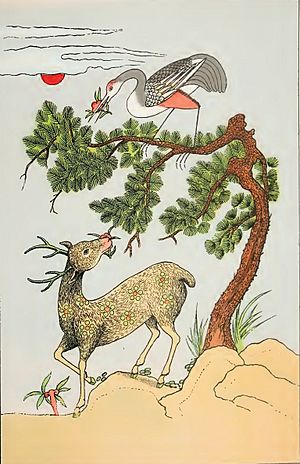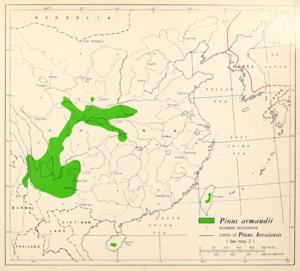Armand pine facts for kids
Quick facts for kids Armand pine |
|
|---|---|
 |
|
| Chinese white pine with deer and red-crested crane | |
| Conservation status | |
| Scientific classification | |
| Genus: |
Pinus
|
| Species: |
armandii
|
 |
|
| Synonyms | |
|
|
The Pinus armandii, also known as the Armand pine or Chinese white pine, is a type of pine tree. It comes from China, growing from southern Shanxi all the way to Yunnan. You can also find it in Anhui and a bit into northern Myanmar. In China, people call it "Mount Hua pine" (华山松).
This tree usually grows in high places, from 1,000 to 3,300 meters above sea level. It can reach up to 35 meters (about 115 feet) tall. Its trunk can be as wide as 1 meter (about 3 feet).
Contents
About the Armand Pine
The Armand pine belongs to a group called "white pines." Like other trees in this group, its leaves (which are like needles) grow in small bundles of five. These bundles have a cover that falls off later. The needles are quite long, usually 8 to 20 centimeters (3 to 8 inches) in length.
The cones of the Armand pine are also big. They can be 9 to 22 centimeters (3.5 to 8.5 inches) long and 6 to 8 centimeters (2.5 to 3 inches) wide. They have strong, thick scales. Inside the cones are large seeds, about 10 to 16 millimeters (0.4 to 0.6 inches) long. These seeds have only a tiny wing. Birds called spotted nutcrackers help spread the seeds around. The cones take two years to fully grow.
There are a few different types, or varieties, of the Armand pine:
- Pinus armandii var. armandii: This is the most common type, found almost everywhere the tree grows.
- Pinus armandii var. mastersiana: This type grows in the mountains of central Taiwan.
- Pinus armandii var. dabeshanensis: You can find this type in the Dabie Mountains near the Anhui and Hubei border. Some people think this might even be a separate species, called Pinus dabeshanensis.
The IUCN keeps track of plants and animals. They have listed Pinus dabeshanensis as vulnerable, meaning it's at risk. The mastersiana variety is listed as endangered, which means it's in even greater danger.
In the past, people thought the Armand pine also grew on Hainan island in China and some islands in southern Japan. However, those pines are now considered different species. They are called Hainan white pine (Pinus fenzeliana) and Yakushima white pine (Pinus amamiana).
How People Use It
The seeds of the Armand pine are collected and sold as pine nuts. These nuts are a tasty snack! Sometimes, eating these nuts can cause a strange taste in your mouth, which is called "pine mouth syndrome."
The wood from the Armand pine is used for general building. It's also an important tree in forestry plantations in parts of China. Many people also plant it as an ornamental tree in parks and big gardens in Europe and North America. The tree's scientific name, armandii, honors a French explorer and scientist named Armand David. He was the first person to bring this tree to Europe.
The Armand Pine in Chinese Culture
In Chinese culture, the Armand pine is very special. Because its leaves stay green all year, it is a symbol of long life and never-ending existence. People in ancient China believed that the tree's sticky sap, or resin, had a living spirit. They thought it was like blood in humans and animals.
Long ago, followers of Taoism, a Chinese philosophy, would eat a lot of pine resin. They hoped it would help them live longer. There's a story about a man named Qiu Sheng. He lived during the time of King Chengtang of Shang (around 1600 BCE). Legend says he lived a very long life because he ate pine resin.
The Shouxing, who is the Chinese god of longevity (long life), is often shown standing near a pine tree. A beautiful fairy-crane is usually perched on one of the tree's branches. In traditional Chinese pictures that show "happiness, honor, and longevity," the pine tree stands for long life. This is similar to how a bat symbolizes good luck because its Chinese name sounds like the word for good fortune.
There's also a type of fungus called Fu Ling that grows on the roots of pine trees. The Chinese believed this fungus could stop hunger, cure many illnesses, and even make people live longer.
Images for kids
See also
 In Spanish: Pino chino de Armand para niños
In Spanish: Pino chino de Armand para niños




